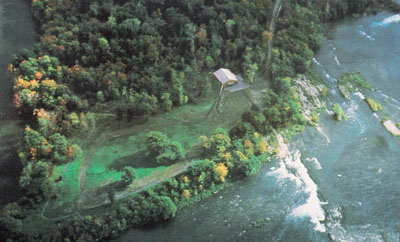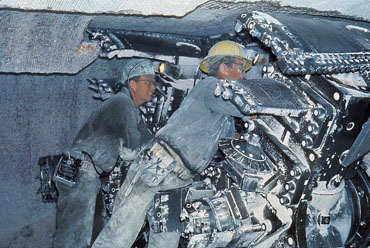Browse "Science & Technology"
-
Article
Pipelines in Canada
Pipelines are systems of connected pipes used to transport liquids and gases — namely oil and natural gas — across long distances from source to market. More than 840,000 km of pipelines criss-cross the country. They represent part of the oil and gas sector which directly and indirectly employs approximately 740,000 people. According to Natural Resources Canada, the sector earns the government an average of $20 billion in royalties, fees and taxes each year (see Natural Resources in Canada). It also contributes nearly 11 per cent of Canada’s gross domestic product. Pipelines, however, have been controversial in Canada. Pipelines help transport fossil fuels and research indicates that fossil fuel use, is significantly contributing to climate change. In recent years, Indigenous groups, environmentalists, municipalities and labour unions have opposed numerous pipeline projects due to the risk of contaminated local waterways from spills and leaks. (See also Environmental Movement in Canada).
"https://d2ttikhf7xbzbs.cloudfront.net/media/media/d582fdd1-da33-4f4e-bb6a-d3573745bd88.jpg" // resources/views/front/categories/view.blade.php
https://d2ttikhf7xbzbs.cloudfront.net/media/media/d582fdd1-da33-4f4e-bb6a-d3573745bd88.jpg
-
Editorial
The 1885 Montreal Smallpox Epidemic
The following article is an editorial written by The Canadian Encyclopedia staff. Editorials are not usually updated. In 1885, smallpox gripped the city of Montreal.
"https://d2ttikhf7xbzbs.cloudfront.net/media/media/9fb27681-8151-488a-a060-ebd52923eb52.jpg" // resources/views/front/categories/view.blade.php
https://d2ttikhf7xbzbs.cloudfront.net/media/media/9fb27681-8151-488a-a060-ebd52923eb52.jpg
-
Macleans
Plane Crash in Fredericton
This article was originally published in Maclean’s magazine on December 29, 1997. Partner content is not updated. Like thousands of other Canadians last week, Krista Kitchen was headed home for the holidays. Flying into Fredericton from Toronto aboard Air Canada Flight 646, the 23-year-old University of Western Ontario student was looking forward to Christmas with family and friends.
"https://development.thecanadianencyclopedia.ca/images/tce_placeholder.jpg?v=e9dca980c9bdb3aa11e832e7ea94f5d9" // resources/views/front/categories/view.blade.php
https://development.thecanadianencyclopedia.ca/images/tce_placeholder.jpg?v=e9dca980c9bdb3aa11e832e7ea94f5d9
-
Article
Plastics-Processing Industry
Plastics are based on giant molecules (polymers) which have a structure so ordered that they can be shaped at elevated temperatures and pressures, ie, these long-chain polymers exhibit "plastic flow" when heated.
"https://development.thecanadianencyclopedia.ca/images/tce_placeholder.jpg?v=e9dca980c9bdb3aa11e832e7ea94f5d9" // resources/views/front/categories/view.blade.php
https://development.thecanadianencyclopedia.ca/images/tce_placeholder.jpg?v=e9dca980c9bdb3aa11e832e7ea94f5d9
-
Article
Platinum
Platinum (Pt) is the best known of the 6 greyish-white, metallic, platinum group elements, which also include palladium (Pd), iridium (Ir), rhodium (Rh), osmium (Os) and ruthenium (Ru). Platinum and palladium are more commonly used than the other elements in the group.
"https://development.thecanadianencyclopedia.ca/images/tce_placeholder.jpg?v=e9dca980c9bdb3aa11e832e7ea94f5d9" // resources/views/front/categories/view.blade.php
https://development.thecanadianencyclopedia.ca/images/tce_placeholder.jpg?v=e9dca980c9bdb3aa11e832e7ea94f5d9
-
Article
Point Amour Lighthouse
In 1858 the Point Amour Lighthouse was built to help sailors through the dangerous waters of the Strait of Belle Isle between Labrador and Newfoundland.
"https://development.thecanadianencyclopedia.ca/images/tce_placeholder.jpg?v=e9dca980c9bdb3aa11e832e7ea94f5d9" // resources/views/front/categories/view.blade.php
https://development.thecanadianencyclopedia.ca/images/tce_placeholder.jpg?v=e9dca980c9bdb3aa11e832e7ea94f5d9
-
Article
Pointe-du-Buisson Archaeological Sites
Pointe-du-Buisson is a small point of land (21 ha) extending into the waters of Lake St Louis (a widening of the St-Lawrence River) at the convergence of the Ottawa River.
"https://d2ttikhf7xbzbs.cloudfront.net/media/media/b8bf0f8e-3c7a-4b11-9fa4-efe4e14a1650.jpg" // resources/views/front/categories/view.blade.php
https://d2ttikhf7xbzbs.cloudfront.net/media/media/b8bf0f8e-3c7a-4b11-9fa4-efe4e14a1650.jpg
-
Macleans
Polar Lander Fails on Mars
No one knows exactly what the surface of Mars is like, but Robert Zubrin has a pretty good idea. At least some of it, he says, is much like a frozen, god-forsaken corner of the Canadian Arctic called Haughton Crater. The terrain is similar - rough-strewn rock on the floor of a crater 16 km across.This article was originally published in Maclean's Magazine on December 20, 1999
"https://development.thecanadianencyclopedia.ca/images/tce_placeholder.jpg?v=e9dca980c9bdb3aa11e832e7ea94f5d9" // resources/views/front/categories/view.blade.php
https://development.thecanadianencyclopedia.ca/images/tce_placeholder.jpg?v=e9dca980c9bdb3aa11e832e7ea94f5d9
-
Article
Polar Vortex
The polar vortex is a wind pattern surrounding the Earth’s poles. Both the North and South pole have polar vortices spinning around them. In both cases, the rotation is generally cyclonic — counter-clockwise around the North Pole and clockwise around the South Pole. While polar vortices exist year-round, they are strongest during each pole’s winter. Canadians tend to experience the effects of the North Pole’s polar vortex toward the end of winter. At this time, the vortex begins to weaken, and cold, polar air travels further south. Polar vortices are atmospheric phenomena which occur on other planets too, such as Mars, Venus and Saturn.
"https://d2ttikhf7xbzbs.cloudfront.net/media/new_article_images/PolarVortex/PolarVortex.jpg" // resources/views/front/categories/view.blade.php
https://d2ttikhf7xbzbs.cloudfront.net/media/new_article_images/PolarVortex/PolarVortex.jpg
-
Article
Population Genetics
Population genetics is the area of genetics that studies the distribution of genes (the units of genetic inheritance) and genotypes (the genetic complement at one or more loci), and the mechanisms determining genetic variability within a population.
"https://development.thecanadianencyclopedia.ca/images/tce_placeholder.jpg?v=e9dca980c9bdb3aa11e832e7ea94f5d9" // resources/views/front/categories/view.blade.php
https://development.thecanadianencyclopedia.ca/images/tce_placeholder.jpg?v=e9dca980c9bdb3aa11e832e7ea94f5d9
-
Article
Post-Traumatic Stress Disorder (PTSD) in Canada
Post-traumatic stress disorder (PTSD) is a mental illness that affects individuals exposed to trauma (although not all people exposed to trauma develop PTSD). Studies suggest that over 70 per cent of Canadians have been exposed to at least one traumatic event in their lifetime, and that nearly 1 out of 10 Canadians may develop PTSD at some point in their lives. PTSD can affect adults and children and can appear months or even years after exposure to the trauma.
"https://d2ttikhf7xbzbs.cloudfront.net/media/media/18a0d81b-c5a9-4ab5-811f-3f413a2d646b.jpg" // resources/views/front/categories/view.blade.php
https://d2ttikhf7xbzbs.cloudfront.net/media/media/18a0d81b-c5a9-4ab5-811f-3f413a2d646b.jpg
-
Article
Potash
Potash is an alkaline potassium compound most commonly used in fertilizers. It refers to a variety of salts produced through mining of minerals and chemical manufacturing. Canada is the world's largest potash producer and exporter (see Exports from Canada). The country’s potash industry is located in Saskatchewan.
"https://d2ttikhf7xbzbs.cloudfront.net/media/media/cd668309-705d-44b0-a404-7a6c5242db9b.jpg" // resources/views/front/categories/view.blade.php
https://d2ttikhf7xbzbs.cloudfront.net/media/media/cd668309-705d-44b0-a404-7a6c5242db9b.jpg
-
Article
Prix du Québec
In 1922, Athanase David, then secretary of the Province of Québec, created 2 prizes to recognize and encourage the work of Québec writers and scientists. The David Prize was created for literature and the Scientific Prize for research.
"https://development.thecanadianencyclopedia.ca/images/tce_placeholder.jpg?v=e9dca980c9bdb3aa11e832e7ea94f5d9" // resources/views/front/categories/view.blade.php
https://development.thecanadianencyclopedia.ca/images/tce_placeholder.jpg?v=e9dca980c9bdb3aa11e832e7ea94f5d9
-
Article
Prospecting
The first organized mineral exploration by Europeans in what is now Canada was led by Martin FROBISHER in his 3 expeditions to Baffin Island (1576, 1577 and 1578).
"https://d2ttikhf7xbzbs.cloudfront.net/media/media/50d17472-14d8-445a-a4f6-cfa35a8e7e85.jpg" // resources/views/front/categories/view.blade.php
https://d2ttikhf7xbzbs.cloudfront.net/media/media/50d17472-14d8-445a-a4f6-cfa35a8e7e85.jpg
-
Article
Psychedelic Research in 1950s Saskatchewan
In the 1950s, Saskatchewan was home to some of the most important psychedelic research in the world. Saskatchewan-based psychiatrist Humphry Osmond coined the word psychedelic in 1957. In the mental health field, therapies based on guided LSD and mescaline trips offered an alternative to long-stay care in asylums. They gave clinicians a deeper understanding of psychotic disorders and an effective tool for mental health and addictions research. Treating patients with a single dose of psychedelic was seen as an attractive, cost-effective approach. It fit with the goals of a new, publicly funded health-care system aimed at restoring health and autonomy to patients who had long been confined to asylums. Click here for definitions of key terms used in this article.
"https://d2ttikhf7xbzbs.cloudfront.net/media/home-page-images/Weyburn-postcard-LXX-1643.jpg" // resources/views/front/categories/view.blade.php
https://d2ttikhf7xbzbs.cloudfront.net/media/home-page-images/Weyburn-postcard-LXX-1643.jpg
